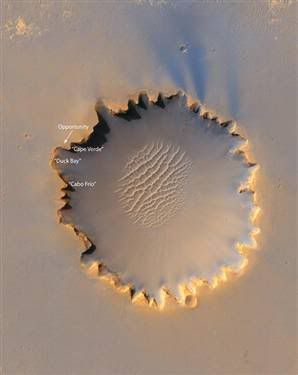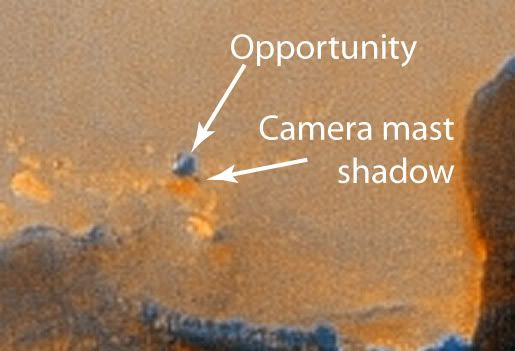
Appearing almost as a shiny boulder, Opportunity’s lumpy outline and its camera-mast shadow can easily be seen in a high-resolution image of Victoria Crater taken by NASA’s Mars Reconnaissance Orbiter (MRO) and released by the space agency on Friday.

“It is so good to see that rover again,” said Steve Squyres, the lead Mars Exploration Rover scientist from Cornell University in Ithaca, New York, during a press briefing. “I’ve got to say that image with that little rover 200 million miles away, parked at the top of that cliff, that’s just one of the most evocative images I’ve ever seen in the planetary program…it’s just beautiful.
At half a mile wide (0.8 kilometers) and 200 feet (60 meters) deep, Victoria Crater is large enough to fit up to five football stadiums inside and is the biggest Martian crater to be visited by NASA’s red planet rovers, mission managers said.
“It’s probably the biggest crater we’re ever going to get to with Opportunity, or in fact with Spirit,” NASA’s Mars exploration program director Doug McQuistion said during the briefing. “The bottom line is it gives us a window on the past of the planet, and that’s incredibly important to understanding why it is the way it is and understanding relationships to potentially other rocky planets in the Solar System.”
Opportunity has spent 21 Earth months exploring the Meridiani Planum region of Mars, eventually working its way from its initial Eagle Crater landing site to Victoria. The rover’s robotic twin Spirit rolled across its own Gusev Crater landing site, scaled one of the region’s Columbia Hills and clambered down the other side. Together, the two rovers have produced some 160,000 images of the red planet.
“I think the whole Mars Exploration Rover program is an example of NASA at its best,” NASA chief Michael Griffin said during the briefing today at the agency’s Washington D.C. headquarters.”
Click the title to read more




No comments:
Post a Comment